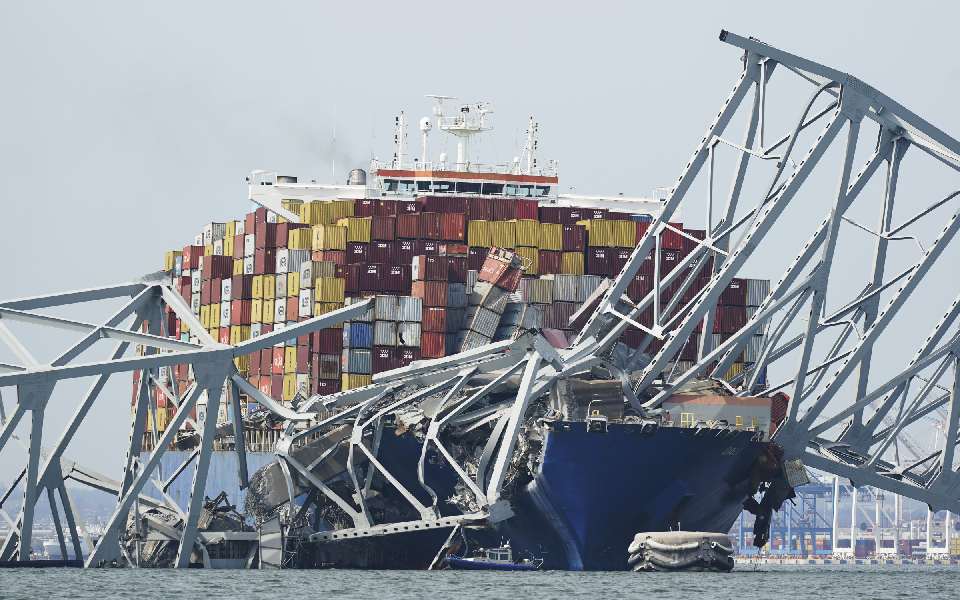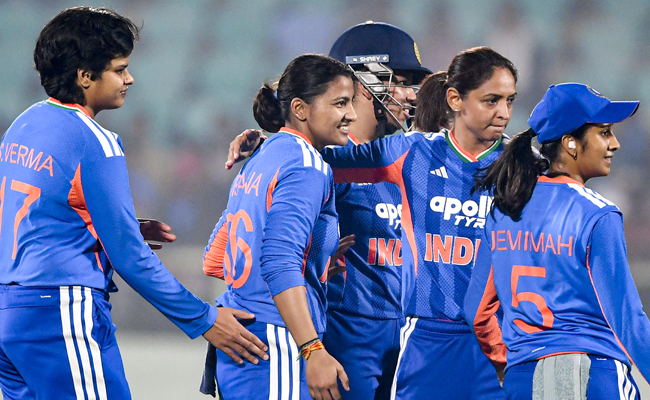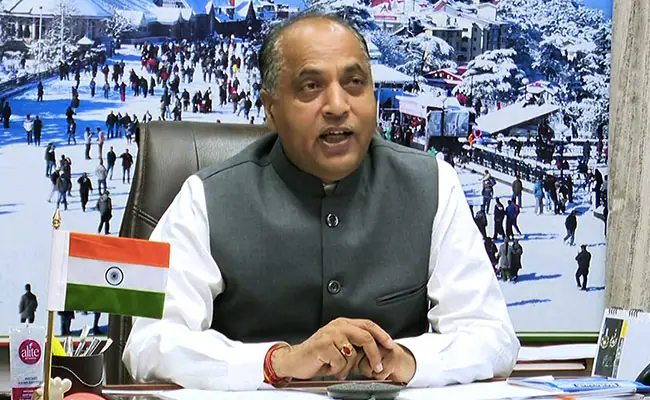New York, Apr 2: The crew of 20 Indians and a Sri Lankan of the crippled container vessel that collided with a key Baltimore bridge last week is “busy with their normal duties” and will remain on board until the investigation into the accident is completed, the company that owns the vessel has said.
The container vessel Dali collided with the 2.6-km-long four-lane Francis Scott Key Bridge over the Patapsco River in Baltimore in the early hours of March 26. The 984-foot cargo ship was bound for Colombo, Sri Lanka.
Just minutes before colliding with the bridge, there was a total blackout on the ship, indicating that the vessel lost engine power and electrical power, according to US media reports.
“It is confirmed there are 21 crew members on board. The crew members are busy with their normal duties on the ship as well as assisting the National Transportation Safety Board and Coast Guard investigators on board," a spokesperson of Grace Ocean Pte and Synergy Marine told PTI.
On how long the crew would have to stay on board the ship, the spokesperson said: “At this time, we do not know how long the investigation process will take and until that process is complete, the crew will remain on board.”
The Singapore-flagged Dali is owned by Grace Ocean Pte Ltd and managed by the Synergy Marine Group. Earlier, the non-profit organisation Baltimore International Seafarers’ Center had said that the Indian crew on board the container vessel was “healthy”.
The Ministry of External Affairs in New Delhi earlier said that there were 20 Indians on board Dali and the Indian embassy in Washington was in close touch with them and local authorities.
Last week, US authorities began interviewing personnel on board Dali. The Synergy Group had said in a statement that the NTSB boarded the vessel on Wednesday and collected documents, voyage data recorder extracts, and other evidence as part of their investigation.
Grace Ocean and Synergy confirmed the safety of all crew members and two pilots aboard the vessel. They, however, reported one minor injury and said the injured crew member had been treated and discharged from a hospital.
Six people, who were part of a construction crew repairing potholes on the bridge when the collision occurred, are presumed dead. Divers recovered the bodies of two of the construction workers from a red pickup truck found submerged in the river and a search was on for the remaining four victims.
US President Joe Biden said that the crew on board Dali had alerted transportation personnel about losing control of the vessel, enabling authorities to close the Baltimore bridge to traffic before the devastating collision, “undoubtedly” saving lives.
Meanwhile, a temporary alternative route for ships is to be opened in the US city of Baltimore following the collapse of, officials announced.
Efforts are underway to remove debris from the water. A 200-tonne piece of the bridge was removed on Saturday.
Those involved in the clean-up have been cutting debris from the bridge into smaller pieces that can be removed and taken to a disposal site.
The collapse of the bridge has effectively shut down operations at Baltimore’s port, affecting about 8,000 jobs and about USD 2 million in daily wages for those workers, US Transportation Secretary Pete Buttigieg said last week.
Between USD 100 million and USD 200 million worth of trade went through the port daily before the bridge’s collapse, and the port was America’s largest for handling vehicle imports, Buttigieg said.
Let the Truth be known. If you read VB and like VB, please be a VB Supporter and Help us deliver the Truth to one and all.
Visakhapatnam (PTI): Shafali Verma hit a blistering unbeaten 69 as India made short work of a paltry target to outclass Sri Lanka by seven wickets in the second Women’s T20 International here on Tuesday.
India now lead the five-match series 2-0 after another one-sided victory, having restricted Sri Lanka to a modest 128 for 9 through a collective display of disciplined bowling from the spin trio of seasoned Sneh Rana, ably complemented by young spinners Vaishnavi Sharma and Shree Charani.
During the chase, vice-captain Smriti Mandhana (14) fell cheaply but Shafali, enjoying new found confidence after a stellar show in the World Cup final, sent the bowlers on a leather-hunt during her 34-ball knock, winning it for her team in just 11.5 overs.
The hosts have now completed back-to-back successful chases within 15 overs which speaks volumes about the unit's sky-high confidence.
Shafali's innings had 11 punchy boundaries apart from a maximum.
The floodgates opened when left-arm spinner Inoka Ranaweera bowled a few flighted deliveries and Shafali would step out everytime to hit her over extra cover. Her footwork against slow bowlers was immaculate whether stepping out to loft the ball or rocking back to punch or pull.
Seeing her confidence, the newly appointed Delhi Capitals skipper Jemimah Rodrigues (26 off 15 balls) also attacked as the duo added 58 runs in just 4.3 overs.
By the time Rodrigues was out trying to hit one six too many, the match as a contest was over. Shafali completed her half-century off just 27 balls and completed the formalities in a jiffy.
Earlier, off-spinner Rana, who got a look-in after Deepti Sharma was ruled out due to fever, showed her utility keeping the Lankan batters under tight leash with figures of 1 for 11 in 4 overs, including a maiden which certainly is a rarity in T20 cricket.
Charani, who made an impression during India's ODI World Cup triumph, took 2 for 23 in her quota of overs, while Vaishnavi after an impressive debut in the opening encounter, finished with 2 for 32, not letting the Islanders get easy runs in her second spell.
The last six wickets fell for just 24 runs, but what stood out during India’s bowling effort was their superb ground fielding. After a patchy show in the previous game, the improved sharpness in the field resulted in three run-outs.
Sri Lankan skipper Chamari Athapaththu (31 off 24 balls) looked in good nick as she deposited length deliveries from seamers Kranti Gaud and Arundhati Reddy over the ropes but it was Rana, who kept her quiet by repeatedly pitching on good length.
Unable to manoeuvre the strike and with the big hits suddenly drying up, Athapaththu chanced her arm at another delivery in which Rana had shortened the length slightly.
Not having transferred the weight into the lofted shot, Athapaththu's hoick was pouched cleanly by Amanjot Kaur at long-off.
This was after Athapaththu's opening partner Vishmi Gunaratne (1) had offered a simple return catch to Gaud.
Hasini Perera (22 off 28 balls) and Harshitha Samarawickrama (33 off 32 balls) did stitch a stand of 44 but they could never set the tempo against the Indian spin troika.
Once Hasini offered a tame return catch off a Charani full-toss, Sri Lankans never recovered and lost wickets in a heap towards the end.





